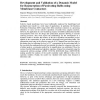Free Online Productivity Tools
i2Speak
i2Symbol
i2OCR
iTex2Img
iWeb2Print
iWeb2Shot
i2Type
iPdf2Split
iPdf2Merge
i2Bopomofo
i2Arabic
i2Style
i2Image
i2PDF
iLatex2Rtf
Sci2ools
CCE
2011
2011
Development and validation of a dynamic model for regeneration of passivating baths using membrane contactors
Selective liquid membranes have been traditionally employed for liquid/liquid and gas/liquid mass transfer in a wide range of applications. In particular, the Emulsion Pertraction Technology (EPT) using hollow fiber membrane contactors is a promising alternative to carry out the selective separation of metals from complex mixtures. However, the application of a new technology requires of reliable mathematical models and parameters that serve for design and optimization purposes allowing to accurate scale-up processes. This work reports the methodology for the development of a dynamic model to describe the kinetics of the EPT separation-concentration process applied to the regeneration of spent trivalent chromium-based passivating baths. The regeneration stage aims at the selective removal of Zn2+ dragged from previous steps in the plating line, not affecting the level of Cr3+ concentration in the passivating bath. In the case study the mathematical model was initially developed in a r...
| Added | 13 May 2011 |
| Updated | 13 May 2011 |
| Type | Journal |
| Year | 2011 |
| Where | CCE |
| Authors | Eugenio Bringas, Rosa Mediavilla, Ana María Urtiaga, Inmaculada Ortiz |
Comments (0)

